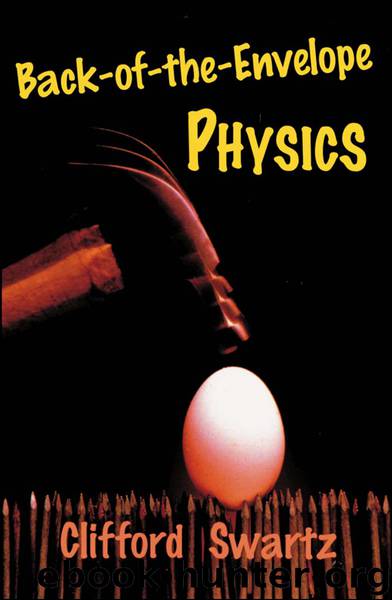Back-of-the-Envelope Physics by Clifford Swartz

Author:Clifford Swartz
Language: eng
Format: epub
Publisher: The Johns Hopkins University Press
Published: 2003-03-09T16:00:00+00:00
SEEING UNDER WATER
An early lesson in learning to swim is to open one’s eyes under water. It must be a little frightening for a child because one can’t see very well under water, even with eyes open. The lens of a healthy eye is a remarkable organ, canceling out imperfections due to spherical and chromatic aberrations. But the major focusing actually takes place at the boundary between air and cornea. The lens just makes second-order corrections to focus the light on the retina. When you are seeing under water, there is very little refraction as the light leaves the water and passes through the cornea. The index of refraction of the cornea and the liquid in the eye is very close to that of water.
Optometrists describe the focusing power of lenses in terms of diopters, , where f is the focal length measured in meters. The smaller the focal length of the lens, the more “powerfully” it focuses. A converging lens has positive power in diopters, and a diverging lens has a negative D. One advantage of this system is that for thin lenses that are close together, the power in diopters just adds linearly:
Download
This site does not store any files on its server. We only index and link to content provided by other sites. Please contact the content providers to delete copyright contents if any and email us, we'll remove relevant links or contents immediately.
| Aeronautics & Astronautics | Astronomy |
| Astrophysics & Space Science | Comets, Meteors & Asteroids |
| Cosmology | Mars |
| Solar System | Star-Gazing |
| Telescopes | UFOs |
Tools of Titans by Timothy Ferriss(8234)
Turbulence by E. J. Noyes(7946)
Secrets of Antigravity Propulsion: Tesla, UFOs, and Classified Aerospace Technology by Ph.D. Paul A. Laviolette(5313)
Astrophysics for People in a Hurry by Neil DeGrasse Tyson(5138)
Room 212 by Kate Stewart(5041)
Design of Trajectory Optimization Approach for Space Maneuver Vehicle Skip Entry Problems by Runqi Chai & Al Savvaris & Antonios Tsourdos & Senchun Chai(5013)
Pale Blue Dot by Carl Sagan(4921)
The David Icke Guide to the Global Conspiracy (and how to end it) by David Icke(4629)
A Journey Through Divination and Astronomy by Publishing Pottermore(4347)
Goodbye Paradise(3732)
Apollo 8 by Jeffrey Kluger(3641)
COSMOS by Carl Sagan(3561)
Losing the Nobel Prize by Brian Keating(3501)
The Five People You Meet in Heaven by Mitch Albom(3476)
How to Read Water: Clues and Patterns from Puddles to the Sea (Natural Navigation) by Tristan Gooley(3411)
Brief Answers to the Big Questions by Stephen Hawking(3371)
How to Read Nature by Tristan Gooley(3256)
The Order of Time by Carlo Rovelli(3146)
A Brief History of Time by Stephen Hawking(2963)
